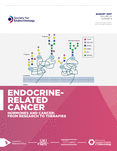Modifiers of breast and ovarian cancer risks for BRCA1 and BRCA2 mutation carriers
- 1Cancer Epidemiology Centre, Cancer Council Victoria, Melbourne, Australia
- 2Centre for Epidemiology and Biostatistics, Melbourne School of Population and Global Health, University of Melbourne, Parkville, Victoria, Australia
- 3Centre for Cancer Genetic Epidemiology, Department of Public Health and Primary Care, University of Cambridge, Cambridge, UK
- Correspondence should be addressed to A C Antoniou; Email: aca20{at}medschl.cam.ac.uk
-
Figure 1
Predicted 5-year breast cancer risks for BRCA2 mutation carriers in the lower percentiles of the combined risk factor distribution. We assumed that all common genetic variants (including the OCCR effect), lifestyle/hormonal factors and mammographic density interact multiplicatively on the risk of developing breast cancer and that they have similar distributions to those observed in the general population, as described in Garcia-Closas et al. (2014). Absolute risks were calculated using the methods described in Antoniou et al. (2010a). The horizontal black line shows the absolute 5-year breast cancer risk at 1.7%, which is the threshold applied in the United States for recommending anti-oestrogens for primary breast cancer prevention in the general population.
- © 2016 Society for Endocrinology












